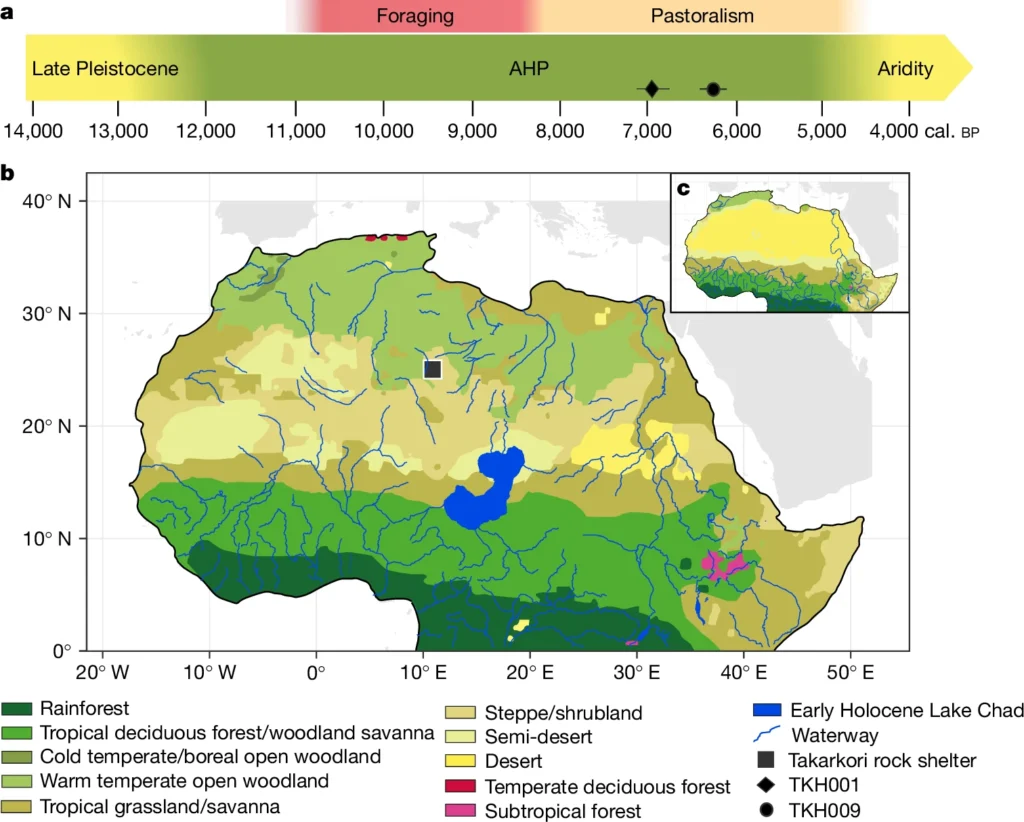A study came out recently which identifies a previously unknown lineage of humans from North Africa which was present during the last wet Saharan period. This lineage is most closely related to North African foragers from the genetically distinctive Iberomaurisian culture, although it differed from them in some ways. It is more closely related to non-African populations than to Sub-Saharans but has extremely low amounts of Neanderthal ancestry, suggesting its people were not back-migrants into North Africa from the Out-of-Africa wave. The implications of all of this in archeology are intriguing.
The finds are based on two female specimens from the Takarkori rock shelter in the Acacus mountains of southwestern Libya from about 7,000 years ago. These people lived during the Neolithic and were pastoralists. They lived during the last of the “Green Sahara” periods, which were periodic phases during the Quaternary when rainfall in what is now the bone-dry Sahara desert were much higher-high enough to support grasslands, lakes, and many animals common further south.

These Green Sahara periods were caused by a strengthening of the west African monsoon which shifted rainfall further north, combined with feedback loops caused by increased vegetation. Amazingly, the effects of the Green Sahara extended into the Arabian desert as well. During the last one-which ended about 5,000 years ago-humans established various forms of agriculture in the Middle East and North Africa.
However, it is not clear how this agriculture would have spread and how much of it was accompanied by migrations. It is known that ancestry from other parts of the Mediterranean such as southern Europe and the Levant penetrated deep into North Africa and forms a large proportion of the ancestry of modern North African populations like Moroccans, Tunisians, Algerians, and Libyans. Yet, it is also known that that there were much more deeply diverged, indigenous lineages in North Africa.

The best-known are the Iberomaurisians, represented by samples from Taforalt in Morocco, who were thought to have about 63% Natufian (ancient Levantine forager) related ancestry with the remainder being from an unknown and diverged Sub-Saharan African lineage. However, the new samples from Takarkori showed a much closer to match to the Sub-Saharan ancestry found in the Taforalt samples.
While the new samples appear to be closer to Out-of-Africa populations than to Sub-Saharan Africans, they do not appear to be largely descended from a back-migration from Asia. This is evidenced by very low levels of Neanderthal ancestry of only 0.15%-less than a quarter found in Taforalt individuals and about 10 times lower than in most non-Africans. The little Neanderthal ancestry that is present seems to be the result of a minor influx of admixture from the Levant.
What does this mean in the context of population genetics history? One, it shows that the Sahara was not necessarily a conduit for migration and mixing even during wet periods. The Saharan pump theory describes the Green Sahara as phases when flora and fauna-including humans-were able to migrate between Sub-Saharan Africa and Eurasia as conditions became more habitable. While this theory is still true, the discovery of another lineage that seems to have been genetically isolated from Sub-Saharan Africans early on makes it clear that there were still barriers (perhaps relict desert regions) preventing easy migration during wet periods.
Further, the fact that the Takarkori individuals were pastoralists who contained minimal Out of Africa ancestry indicates that the spread of culture and technology need not be accompanied by large-scale demographic movements.
References
Salem, N., van, Sümer, Arev Pelin, Vai, S., Hübner, A., Peter, B., Bianco, R. A., Lari, M., Modi, A., Faraj, M., Turjman, M., Bouzouggar, A., Tafuri, M. A., Manzi, G., Rotunno, R., Prüfer, K., Ringbauer, H., Caramelli, D., Savino, di L., & Krause, J. (2025). Ancient DNA from the Green Sahara reveals ancestral North African lineage. Nature, 1–7. https://doi.org/10.1038/s41586-025-08793-7